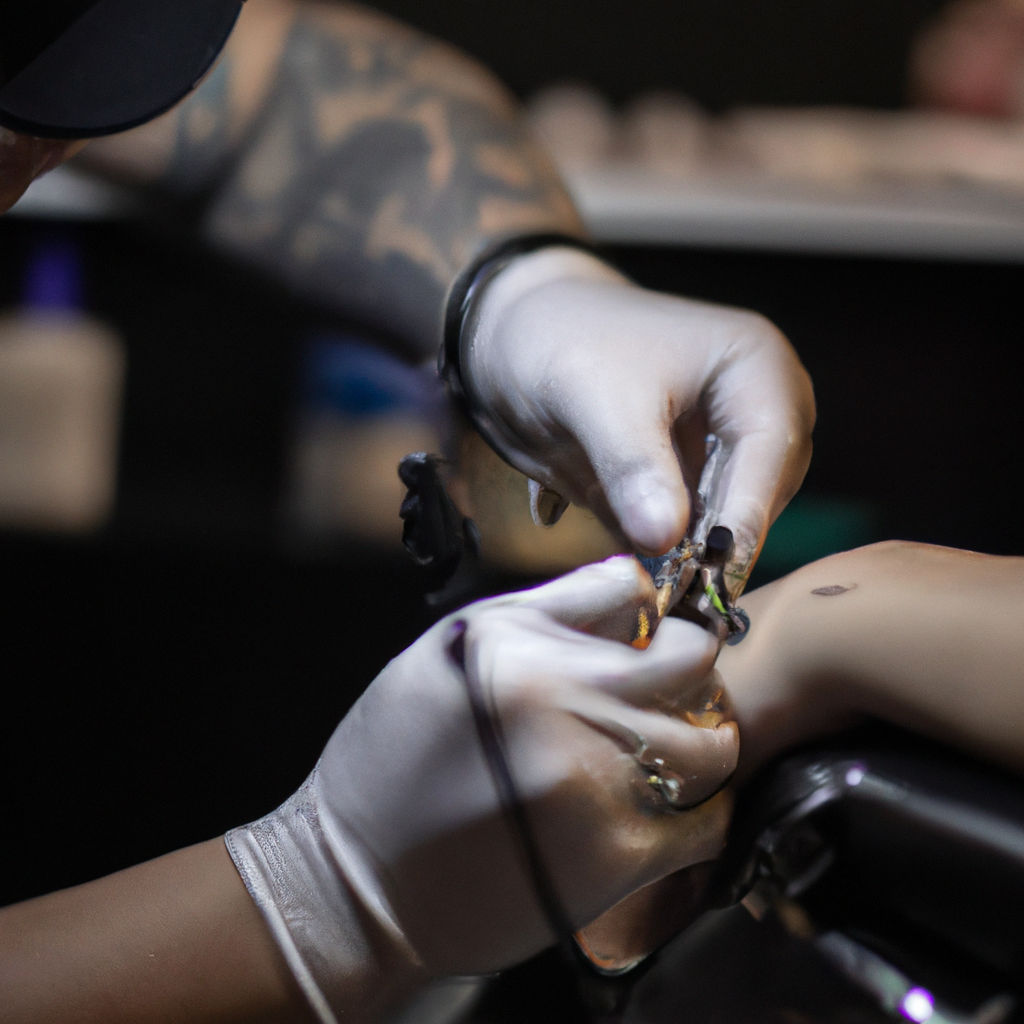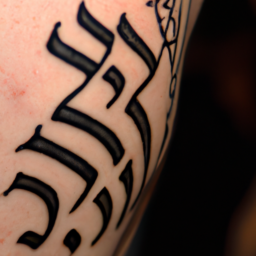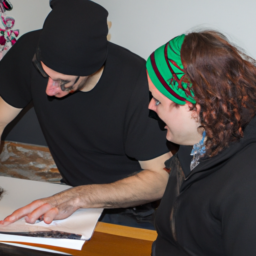“Exploring the Beauty of Hebrew Tattoo Designs: A 2024 Inspiration Guide”
The mystical lure and striking aesthetics of Hebrew tattoo designs truly stand them out from the crowd. In our culturally diverse and globally-connected society, the unique beauty and profound significance these tattoos carry is increasingly being recognized and cherished. The cultural and historical implications of Hebrew tattoos extend far beyond mere body art, representing a lifetime commitment to age-old traditions and deeply rooted beliefs for many.
The Rising Popularity of Hebrew Tattoos
As we traverse through the year 2024, the upsurge in the popularity of Hebrew tattoos is indeed striking, particularly among adults aged 25 to 54. The reasons behind this surge go beyond mere fashion or trend following.
Desire for meaningful tattoos is one of the major influences driving this trend. The profound symbolism and inherent depth in Hebrew script often complement the meaningful narratives individuals wish to represent through their tattoos. Besides, the aesthetic quality of Hebrew tattoos also plays an integral role in this rising trend. The sleekness of the Hebrew script, combined with its exotic allure, make these designs visually striking and immensely appealing.
Furthermore, an increasing number of people are expressing an affinity towards Hebrew culture and language. Such individuals choose Hebrew tattoos to establish a personal connection to these ancient traditions, to pay homage, or to celebrate their Jewish heritage.
What makes Hebrew tattoos truly unique, however, is the combination of their artistic appeal with the deep cultural, historical significance they carry. These aspects intertwine to make Hebrew tattoos more than mere body art – they become a personal statement of belief, identity, and respect for a rich ancient culture.
Artistic Appeal of Hebrew Tattoos
The allure of Hebrew tattoos stems from the unique aesthetics of the Hebrew script itself. The Hebrew language is written from right to left, unlike most other languages, presenting a whimsically reversed perspective to the onlooker. Every letter in this ancient script carries a unique design, different in appearance from traditional Latin textual characters. These letters resonate a captivating symmetry, appearing almost like an elegant piece of art when inked on the skin.
One of the key attractive features of Hebrew tattoos is their distinctive form. The Hebrew script is a type of “abjad,” meaning each character provides a consonantal building block. Vowel sounds, which are potentially applied via diacritical markings known as “niqqud,” are frequently omitted, rendering the literal reading of a Hebrew tattoo a unique prominence. This enigmatic quality adds an extra dose of enchantment to the overall beauty of the design.
Ancient Origins of Hebrew Script
< h3>Painting Histories with Tattoos
The allure of Hebrew tattoos is not only encapsulated in their aesthetic appeal, but also extends to their historical significance. The Hebrew script is one of the oldest, tracing its roots back to around 1000 BC. This ancient language has weathered the ebb and flow of time, evolving continuously yet retaining its minted charm.
The Hebrew script is a derivative of the Phoenician script, which was later adjusted during the Babylonian captivity. The final version, also known as the “square script,” forms the basis of modern Hebrew. The rich history associated with the script, its survival through centuries, and its evolution adds an enthralling layer to Hebrew tattoos.
These tattoos are more than just body art—they are symbolic representations of an extensive cultural heritage. When individuals choose to etch their flesh with this timeless script, they are essentially embedding a piece of history onto their skin, transforming their bodies into a living canvas for ancient narratives.
Thus, the artistic appeal and lyrical charm of Hebrew calligraphy, combined with its esteemed historical and cultural relevance, elevate Hebrew tattoos to an art form that represents more than physical aesthetics. They encapsulate stories, histories, and convictions, resonating profound significance every time.

The Significance of Hebrew Symbols in Tattoos
Hebrew culture is steeped in powerful symbols intertwined with profound meanings. These symbols not only capture the mesmerizing aesthetic beauty of the Hebrew script but also showcase profound religious, cultural, and historical connotations. For example, the Star of David, a six-pointed star, is a widely recognized symbol of Judaism and a popular choice among those desiring a Hebrew tattoo. Moreover, the Hamsa Hand, a symbol of protection, and the Chai, symbolizing life, are also prevalent Hebrew symbols used in body art.
The Hebrew language is additionally cherished for its deep-rooted significance. Many individuals are captivated by the depth of meaning that Hebrew letters carry and choose to embody these symbols in their tattoos. The letters Alef and Bet, or the entire Aleph-Bet in sequence, are examples of these. Each letter not only represents a phonetic sound but also holds its own philosophical, and numerical meaning.
Popular Hebrew Tattoo Designs
In the contemporary body art world of 2024, Hebrew tattoos are among the top trending designs. Their timeless beauty and profound meanings have captivated a whole new generation.
One of the most popular Hebrew tattoo designs is ingraving words or phrases in Hebrew letters. Commonly, these can be quotes from the Bible or popular Hebrew phrases like ‘Ahava’ meaning ‘love’, or ‘Chesed’ signifying ‘kindness’. Each letter’s intricately stylized form makes these tattoos visually striking, enhancing their appeal even further.
Another preferred design is the ‘Tree of Life’. This biblical symbol, representing humanity free from corruption and sin, has become a modern favorite due to its strong symbolism and beautiful imagery.
Combining Hebrew letters to form geometrical patterns or abstract art is another trend within Hebrew tattoo designs. It merges the classic beauty of Hebrew script with a modern flair.
The profound gravity and intricately captivating aesthetics of these Hebrew tattoo designs continue to trend, testifying to the enduring influence of the Hebrew culture on modern art.
The Modern Interpretation and Twist in Hebrew Tattoos
The surge in the popularity of Hebrew tattoos has ignited a creative revolution, leading to a plethora of modern interpretations. These new-age designs combine the allure of traditional Hebrew scripts with contemporary aesthetics, artistically bridging the gap between ancient inspiration and contemporary expression.
Hebrew tattoos today embody this fusion – they maintain their roots in scripture while seamlessly incorporating the personalized preferences of today’s adults aged between 25-54. For instance, many individuals opt for designs that merge classic Hebrew symbols with abstract or geometric forms, adding a fresh perspective to the orthodox aesthetic. Simultaneously, the interpretations employ minimalistic designs coupled with distinct Hebrew letters, a style favored highly in the current tattoo trend.
The evolution of Hebrew tattoos is a testament to the fact that the acceptance and appreciation for such designs are not strictly confined to religious reasons or Jewish heritage. To many, they serve as a medium to express aesthetic creativity and individualism.
Case Studies – Stories Behind Hebrew Tattoos
Hebrew tattoos have more to offer than just unique aesthetic appeal. Each tattoo carries a gripping narrative for its bearer, often speaking volumes about their life experiences, beliefs, or sentiments. Here, we delve into a few compelling stories behind Hebrew tattoos, revealing their personal significance.
In one such instance, an individual opted for a Hebrew tattoo symbolizing ‘strength’. Having endured a tumultuous past, the tattoo was a constant reminder of their resilience and the ability to overcome adversity.
Another intriguing case features a woman who chose the Hebrew word ‘Ahava’, meaning ‘love’. It symbolizes her unshaken belief in love and the need to spread it, even amidst seemingly insurmountable challenges.
In a distinct scenario, a man went for a Hebrew tattoo translating to ‘faith’. To him, this piece of art served as a daily reminder of the unyielding faith that had guided him through life.
There are countless such stories where Hebrew tattoos have carried a profound meaning for their bearers, going beyond being just a fascinating conversation starter. Behind every Hebrew tattoo, there resides an array of emotions, memories, and sentiments waiting to be told, making them a trendy yet thoughtful choice.

Crucial Tips to Avoid Pitfalls When Getting a Hebrew Tattoo
Before you proceed to get your next or first Hebrew tattoo, you need to bear in mind the potential pitfalls that could mar the overall outcome or significance of your body art. Hebrew tattoos carry deep historical meanings, and careful attention to the correct translation and cultural sensitivity are of paramount importance.
The key pitfall to avoid is incorrect translation. Since Hebrew is a semitic language, it reads from right to left, which is the exact opposite of English and other Latin-based languages. Therefore, getting the translation right is crucial. Always seek translation assistance from a native Hebrew speaker or an expert in the language. Avoid relying on free online translation tools – they might not give you the accurate and precise meaning you desire for your tattoo. An incorrectly translated tattoo can turn out to be embarrassing or disrespectful unintentionally.
Respecting the Hebrew Culture and Religion
Another important aspect is respecting the culture and religion associated with Hebrew scripts. Hebrew is closely linked to Judaism, and some Hebrew letters and symbols have sacred connotations. To avoid offending religious sensitivities, you should research thoroughly or consult knowledgeable persons about the intended meaning and appropriateness of your chosen design.
Getting a Hebrew tattoo can be a beautiful way to express your identity, beliefs, or connections. However, it’s essential to tread carefully to ensure respect to the complex and rich heritage associated with the Hebrew language and culture. Expert tips and advice can guide you in the process of authenticity while respecting the culture simultaneously. A well-thought-out and carefully designed Hebrew tattoo can then stand as a testament to your appreciation for this ancient and profound language and culture.

To conclude, Hebrew tattoos are unique in both their beauty and the richness of their inherent meanings. Drawing upon a deep well of cultural, historical, and religious significance, these designs offer an irresistible blend of artistry and profound symbolism. Every stroke of the Hebrew script tells a story, crystallizing centuries of heritage into a permanent mark. Each enchanting design shines forth, radiating its distinct aura, capturing attention and evoking curiosity, thus adding an extra layer of personal significance to the bearer’s story.
As the aesthetic appeal continues to charm the demographic of adults aged 25-54, we observe a burgeoning trend of these tattoos in the recent past, signifying the global appreciation for the depth and worth this ancient script represents. The modern reinterpretation of Hebrew tattoo designs lends a distinctive flavor to the traditional symbols, further broadening their appeal.
However, it’s crucial that one exercises due care when opting for a Hebrew tattoo, taking utmost precautions to avoid common pitfalls such as incorrect translations or cultural insensitivities. Ensuring the authenticity of the design and honoring the culture it originates from always needs to be at the forefront. After all, these tattoos are more than just ink on skin; they are a testament to the powerful symbiosis of artistry and profound meaning.
As we delve deeper into the world of Hebrew tattoos, let’s celebrate their magnificence, and acknowledge the myriad stories they tell. Let’s appreciate the depth of the ink that marks the skin not just with a beautiful design but an emblem of personal significance, a testimonial of a culture steeped in rich history, and a beacon of faith, love, and hope. Such is the allure of the Hebrew tattoo; truly a treasure worth exploring.

